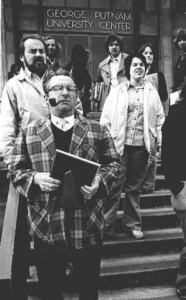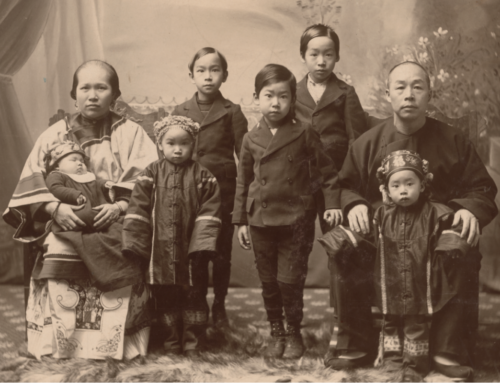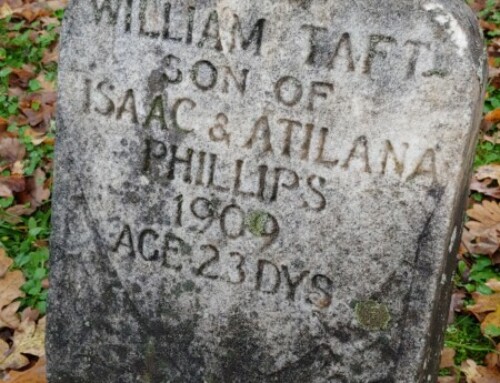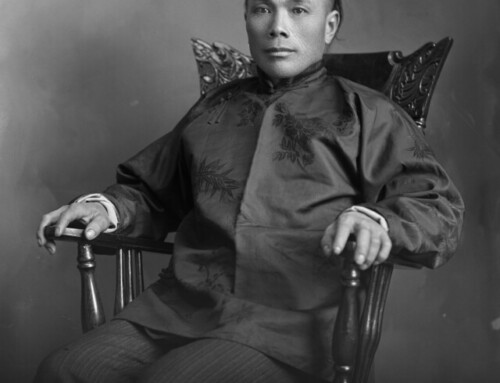Carl Hall
His art is featured at the Hallie Ford Museum of Art.

1975-4-02, Artist Carl Hall (in plaid jacket) stands on the stairs of George Putnam University Center with students and faculty. Photo was taken at Willamette University, Salem, Oregon April 2, 1975., Salem Public Library SJ1200
For fifty years, the beauty of the Willamette Valley, the Oregon coast, and Salem itself continued to appeal to the imagination of Carl Hall. While he lived here, he honored the landscape he had adopted as his own by translating the colors and patterns he saw into hundreds of expressive paintings. Since his death in 1996, the Hallie Ford Museum of Art has returned the honor by naming one of its six exhibition spaces, The Carl Hall Gallery of Pacific Northwest Art, as a tribute to him.
Carl Hall was born in Washington, DC in 1921, the second of the seven children of Ella and Walter Hall. During his childhood, his family moved to Detroit where his father worked in the Packard automobile plant. By fifteen, Hall was painting. Two years later, in 1938, he was offered a scholarship to an art school, the Meinzinger School of Art, where he studied at night while completing his senior year high school courses. He remained there for three more years.
Within a few years, the paintings he had produced during this time were being seen in the Boston Museum of Fine Arts, the Museum of Modern Art in New York, and the Art Institute of Chicago. In 1943 a New York art dealer wrote to Carl’s father offering to be the dealer handling his pictures in New York. One might ask why didn’t the young artist, already gaining some recognition, continue his career one of these metropolitan centers?
Like other young men of 1942, he was called into the military forces and sent to Camp Adair near Corvallis, Oregon. Further training took him to Camp White near Medford, where he met his future wife, Phyllis Blake of Ashland (formerly of Michigan). They were married in 1944, three days before he was shipped out to the Philippines where he was a combat artist. His work was published in Life magazine.
After the war, the Halls choose Salem for their home. By 1948 he was teaching art at Willamette University. In an article by Roger Hull, “Painting Oregon: Carl Hall’s Northwest Art,” published in Historic Marion, Autumn 1998, the artist and his work is described as follows:
“Retiring in 1986, his nearly forty-year association with the university resulted in his reputation as an educator as well as an artist and helped anchor him and his growing family in Salem’s cultural and civic life of the 1950s, ‘60s, and ‘70s. Anchored by the university and the valley, a family man by temperament, and a loner by reputation, Hall forged a distinctive and influential Northwest style. In contrast to the muted, laid back style of such Portland-associated painters of the Northwest School as Harry Wentz, Charles Heaney, or the Renquist brothers, or the brushy turbulence of Constance Fowler, Hall’s art was tighter, tenser, putting almost an old master technique in the service of hallucinatory, high octane images.”
On 19 August, 1993, Ron Cowan of the Statesman Journal wrote about the artist in his retirement. At the age of 71, Carl Hall had suffered three minor strokes, but he was still active in his art – just working at a slower pace. This article also contains a description of his work:
“Although he has painted the human form and some of his most moving works are his sketches from the war, the natural world dominates some of his finest work. But the realism in his oils, acrylics and watercolors is transformed by emotion, the surfaces and objects coming alive under his brush.”
Cowan wrote: “Although his work is in many important public and private collections and has been exhibited by the Seattle Art Museum and the Museum of Modern Art in New York, his love for Oregon limited his national prominence.
Hall, who still has much of his output at home, doesn’t complain.
‘I would have had a different career if I’d gone to New York. I had to make the choice, and I have no regret I made the choice.’
His home, with a Japanese-style garden he designed and his wife, Phyllis, planted, reflects his love of the natural world, as does his art.”
Compiled by Virginia Green.
This article originally appeared on the original Salem Online History site and has not been updated since 2006.








Leave A Comment